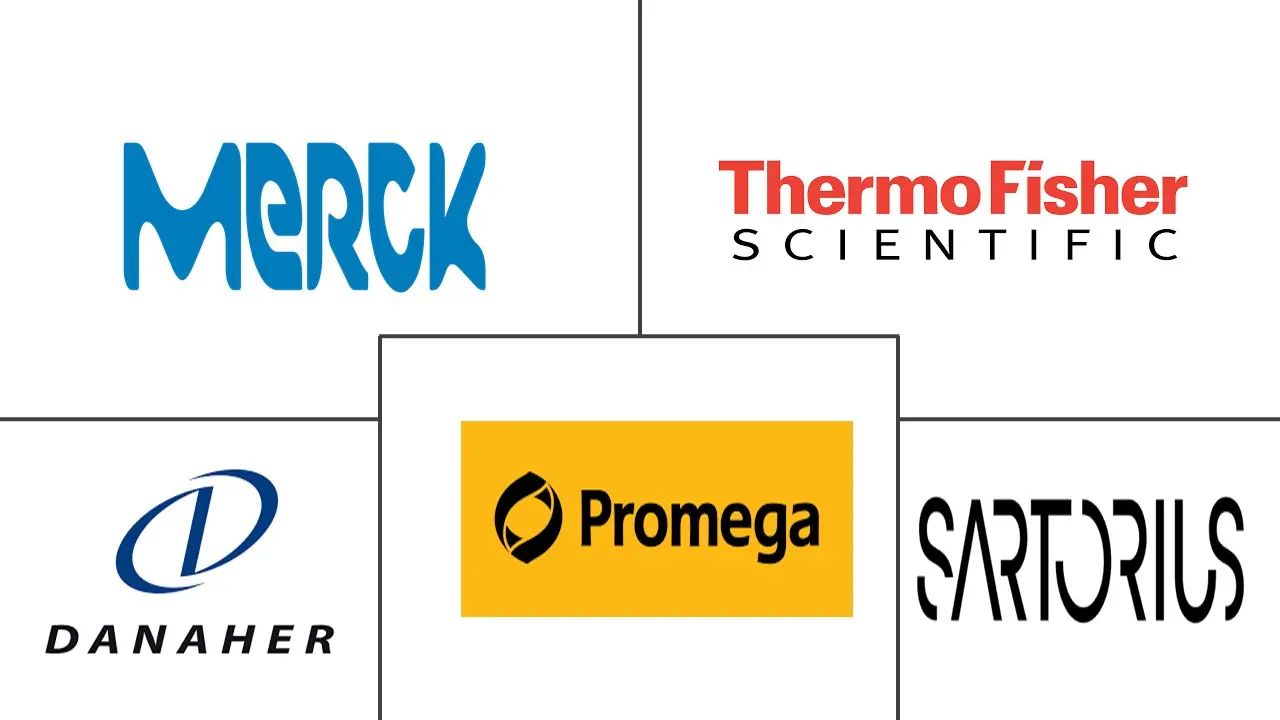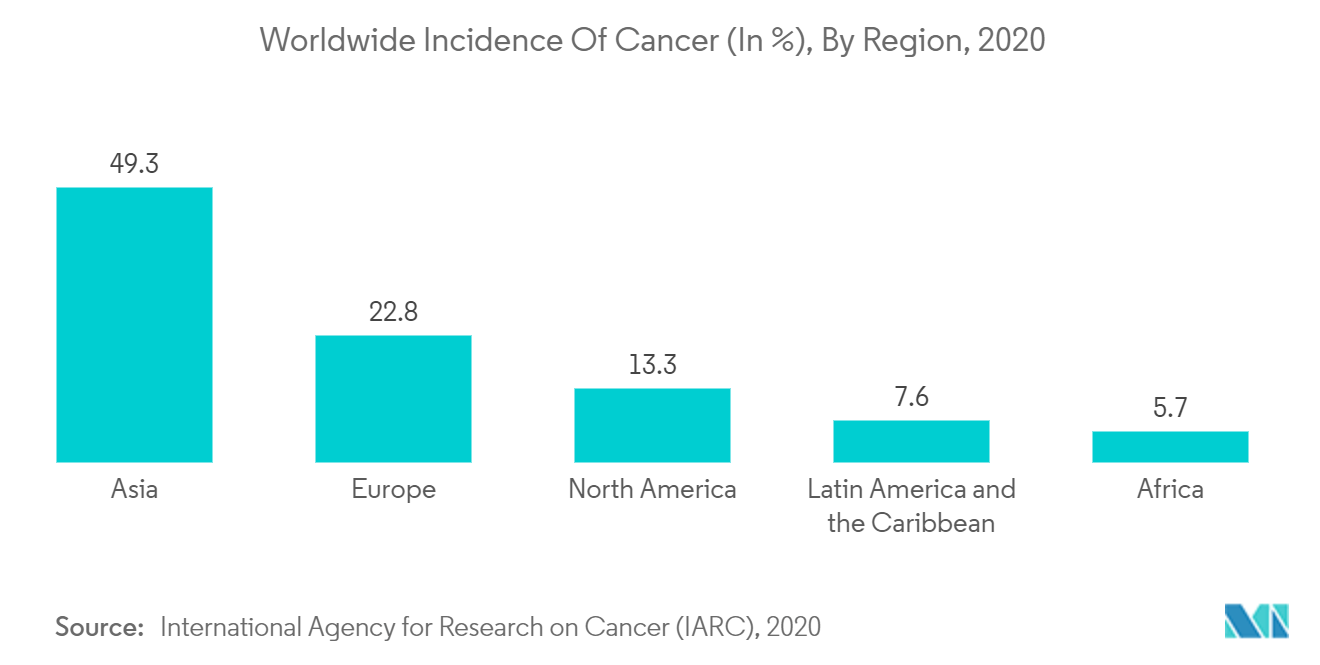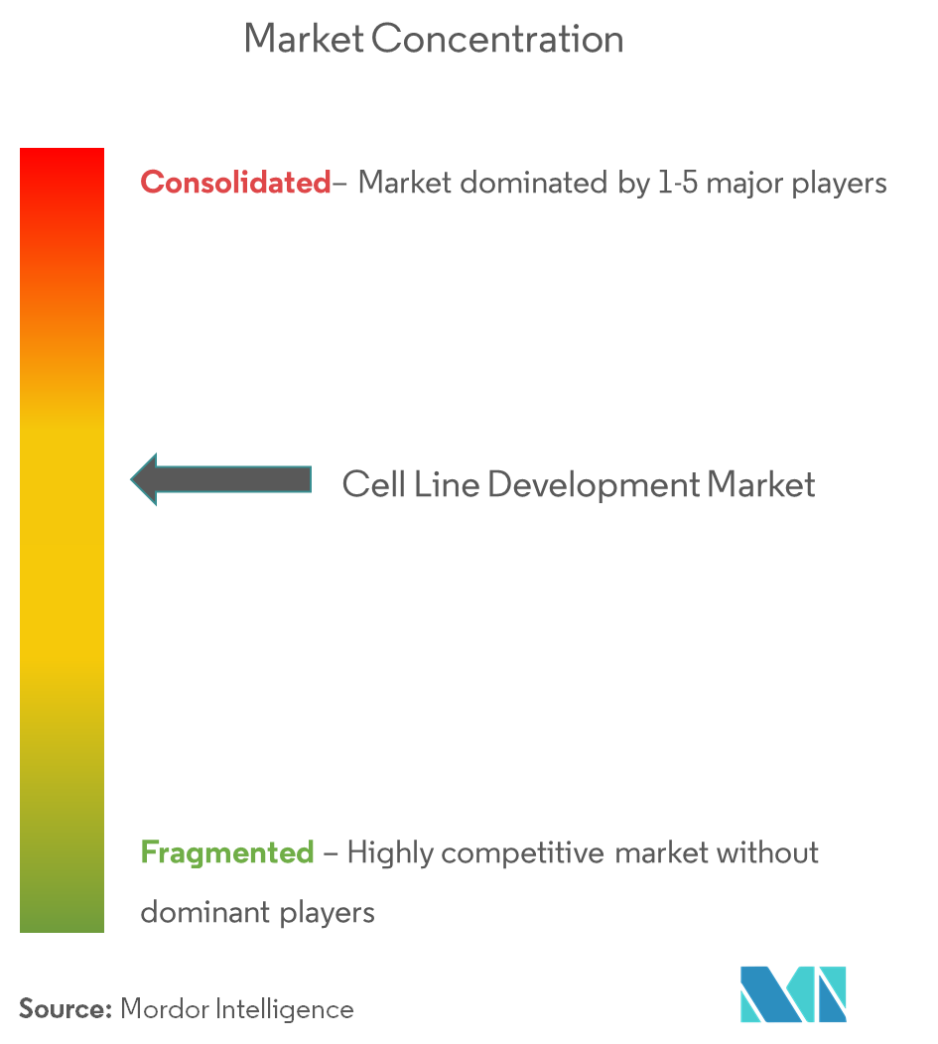
| Study Period | 2019 - 2030 |
| Base Year For Estimation | 2024 |
| Forecast Data Period | 2025 - 2030 |
| CAGR | 10.60 % |
| Fastest Growing Market | Asia-Pacific |
| Largest Market | North America |
| Market Concentration | Medium |
Major Players
*Disclaimer: Major Players sorted in no particular order |
Cell Line Development Market Analysis
The Global Cell Line Development Market is expected to register a CAGR of 10.6% during the forecast period.
In March 2020, the World Health Organization (WHO) classified COVID-19 as a pandemic. Since that time, the mortality rate from chronic diseases has grown dramatically. As a result of the rising demand for vaccine development, COVID-19 is seen to have a positive effect on the cell line development industry. According to the study titled "Scientists develop suitable human cell line for anti-SARS-CoV-2 drug screening" published in the Journal of Virus in March 2022, Researchers have described the creation of a suitable human cell line for the high-throughput testing of antiviral medications that target the coronavirus 2 that causes severe acute respiratory syndrome (SARS-CoV-2). Angiotensin-converting enzyme 2 (ACE2) and transmembrane serine protease 2 (TMPRSS2), two essential host proteins required for viral entry, were engineered to express high levels in the human lung carcinoma cell line A549. As a result, more cell lines are being developed to manage COVID-19, which had a significant impact on the market under study during the pandemic.
The market is driven by the growing biopharmaceutical industry, rising demand for monoclonal antibodies and cancer therapeutics, and growing production of biosimilars due to the patent expiry of branded therapeutics.
Due to changes in dietary practises, a lack of physical activity, and general changes in lifestyle, cancer has become more prevalent over the past ten years. In addition, the demand for cell line development will rise as vaccine production expands and technology advances. According to the GLOBOCAN 2020 report, the total number of people in the world affected by cancer in 2020 accounts to around 19.29 million cases. The number is estimated to rise to 28.89 million cases by 2040. The use of cell lines in the production of biological cancer drug substances is increased due to increasing in cancer burden hence the cell line development market is expected to grow over the projecting period.
Moreover, growing production of biosimilars due to the patent expiry of branded therapeutics is expected to drive the growth of the market. cell line development play an important role in manufacturing and development of the biosimilars. Biosimilars increase market competition and facilitate patient access to life-saving medications. The primary objective of biosimilar producers is to lower treatment costs. For instance, according to the study titled "Expected Impact of Biosimilars on the Pharmaceutical Companies" published in the Iranian Journal of Medical Science in September 2021, In the markets of France, Germany, Italy, Spain, and the UK, patients now have a 44% greater access to these products as a result of the introduction of biosimilars in the European Union (EU). Therefore, it is anticipated that the development of biosimilar products will increase, making therapeutics more accessible to the individual and accelerating market growth. Moreover, growing launch of the biosimilars expected to accelerate the market growth. For instance, in June 2022, Biogen and Samsung Bioepis reported that Byooviz (ranibizumab-nuna) has been launched on the United States market as ophthalmology biosimilar.Thus, increasing biosimilar launches and patent expirations both had positive effects on market growth.
The above-mentioned statistics indicate the high burden of cancer across the world, which is expected to drive the growth of cell line development market, as there is been an increasing demand for the novel therapeutics to deal with cancer.
Cell Line Development Market Trends
Mammalian Cell Line Development is Expected to Register Rapid Growth Over the Forecast Period
The mammalian cell line development segment is anticipated to experience profitable growth in the future. This is because more mammalian cell sources are being used to create monoclonal antibodies. These cell lines produce intricate proteins that are reminiscent of those in the human body, aiding in the creation of customized medications. Additionally, human tissues and other biological components can easily adapt to mammalian cell lines, lowering the risk of infection. It is anticipated that these benefits of mammalian cell lines will increase the demand for cell line development. According to the study titled "Methods for transient expression and purification of monoclonal antibodies in mammalian cells" published in the Advances in Protein Molecular and Structural Biology Methods in March 2022, the production of human antibodies in animals (mouse or rabbits) from polyclonal to Monoclonal antibodies (mAbs), from murine to chimeric antibody, and finally modified to fully humanized mAbs, serves as a desirable therapeutic tool for clinical research and academic study. Thus, increased development of the mammalian cell line to create the monoclonal antibodies which are used in the treatment of various chronic diseases expected to boost the growth of the segment.
According to the Pharma Manufacturing Updates in July 2021, nearly 20 medications, including a few blockbusters like Novartis' Entresto and Biogen's Spinraza, are expected to have their patents expire in 2023. In addition, the expiration of branded drugs has given rise to the emergence of biosimilars. As a result, there has been a growing demand for cell line development. Most of the biopharmaceutical companies that develop mammalian cell lines are based on either the methotrexate (MTX) amplification technology or the glutamine synthetase (GS) system.
With the utilization of mammalian cell lines, the cell clones obtained are highly heterogeneous and large numbers of cell clones have to be screened to identify rare stable high producer cell clones. To make the screening process easier, there have been several advances done in mammalian cell line development, which has been making it the more preferred source for cell line development. For Instance, in May 2022, ProteoGenix, a contract research organization specializing in biologics discovery and bioproduction launched its XtenCHO Transient Expression System. Due to its enhanced plasmid stability and optimized metabolism, the new proprietary mammalian cell-based expression host achieves up to ten times higher yields with less hands-on time compared to existing solutions. The new CHO host aims to simplify recombinant protein production and accelerateearly-phasee drug screening
Therefore, with the advancements being done in mammalian cell lines, the segment is expected to witness healthy growth in the future.

United States Dominates the Market
North America dominates the cell line development market over the forecast period. The United States has a better healthcare infrastructure, compared to most developed countries. The presence of key players in the United States is the major factor propelling the growth of the market studied in the country. Furthermore, support from the United States government to accelerate the research in the biotechnology and biopharmaceutical industry has been augmenting the demand for cell line development and technological advancements, and increased research and development spending has contributed to high regional growth.
The major factors driving the growth of the studied market in the region include the high incidence of chronic diseases, such as cancers, along with the increased investment in research and development activities by the major players. According to the American Cancer Society Facts and Figure 2021, the number of cancer deaths and new cases estimated for 2021 was 1.9 million new cancer cases diagnosed and 608,570 cancer deaths in the United States.
However, the growing development of biosimilars in the united states is expected to boost the market growth. For instance, in June 2020, Pfizer Inc. received the FDA approval for its pegfilgrastim biosimilar, Nyvepria, indicated for use in lowering the incidence of infection. Thus, in view of the high incidence of chronic diseases, such as cancers, and increasing research and development (R&D) activities, the market is expected to propel significantly over the forecast period in North America.
Furthermore, growing launches by the technological advanced product for the cell line development is expected to boost the market growth. For Instance, in October 2021, A new platform for completely automated stable cell line development has been introduced by CYTENA, a BICO company. The platform combines CYTENA's best-in-class liquid handling expertise with its already successful single cell dispensing technology to enable cost-effective and superior laboratory automation. The democratisation of access to the production of next-generation healthcare solutions, such as antibody therapies, gene therapies, and biosimilar production, furthers BICO's Bio Convergence agenda.
Thus, in view of the high incidence of chronic diseases, such as cancers, and increasing R&D activities, the market is expected to propel significantly over the forecast period in North America.

Cell Line Development Industry Overview
The cell line development market is moderately competitive and consists of several major players. In terms of market share, few of the major players currently dominate the market. The presence of major market players, such as Thermo Fisher Scientific, Sartorius AG, Promega Corporation, and Merck KGaA, has been, in turn, increasing the overall competitive rivalry in the market. Product advancements and improvement in the cell line development technology by the major players have been increasing the competitive rivalry.
Cell Line Development Market Leaders
-
Promega Corporation
-
Danaher Corporation
-
Sartorius AG
-
Thermo Fisher Scientific
-
Merck KGaA
- *Disclaimer: Major Players sorted in no particular order

Cell Line Development Market News
- In July 2022, ProBioGen and Granite Bio Collaborate to Provide GMP Manufacturing and Cell Line Development Services. A novel monoclonal antibody developed by Granite Bio is the company's top contender for the treatment of autoimmune and specific cancer indications. By using the DirectedLuck transposase.
- In June 2022, FUJIFILM Corporation announced the investment of USD 1.6 billion to enhance and expand the cell culture manufacturing services of FUJIFILM Diosynth Biotechnologies, a subsidiary of FUJIFILM Corporation, and world-leading contract development and manufacturing organization (CDMO)
Cell Line Development Industry Segmentation
As per the scope of this report, the cell line development market includes the types of equipment that have been used in the process along with the source from where the cell is extracted. Furthermore, the market studied includes different types of cell lines and the end users of the same. The Cell Line Development Market is segmented by Product (Reagents and Media, Equipment, Finished Cells, and Other Products), Source (Mammalian Cell Line, Non-mammalian Cell Line), Application (Recombinant Protein Expression, Hybridomas Technology, Vaccine Production, Drug Discovery, Other Applications) End User (Biotech and Pharmaceutical Companies, Academics and Research Institutes, Other End Users) and Geography (North America, Europe, Asia-Pacific, Middle East & Africa, and South America). The market report also covers the estimated market sizes and trends for 17 different countries across major regions, globally. The report offers the value (in USD million) for the above segments.
| By Product | Reagent and Media | ||
| Equipment | |||
| Finished Cells | |||
| Other Products | |||
| By Source | Mammalian Cell Line | ||
| Non-mammalian Cell Line | |||
| By Application | Recombinant Protein Expression | ||
| Hybridomas Technology | |||
| Vaccine Production | |||
| Drug Discovery | |||
| Other Applications | |||
| By End User | Biotech and Pharmaceutical Companies | ||
| Academics and Research Institutes | |||
| Other End Users | |||
| Geography | North America | United States | |
| Canada | |||
| Mexico | |||
| Europe | Germany | ||
| United Kingdom | |||
| France | |||
| Italy | |||
| Spain | |||
| Rest of Europe | |||
| Asia-Pacific | China | ||
| Japan | |||
| India | |||
| Australia | |||
| South Korea | |||
| Rest of Asia-Pacific | |||
| Middle East and Africa | GCC | ||
| South Africa | |||
| Rest of Middle East and Africa | |||
| South America | Brazil | ||
| Argentina | |||
| Rest of South America | |||
Cell Line Development Market Research FAQs
What is the current Global Cell Line Development Market size?
The Global Cell Line Development Market is projected to register a CAGR of 10.6% during the forecast period (2025-2030)
Who are the key players in Global Cell Line Development Market?
Promega Corporation, Danaher Corporation, Sartorius AG, Thermo Fisher Scientific and Merck KGaA are the major companies operating in the Global Cell Line Development Market.
Which is the fastest growing region in Global Cell Line Development Market?
Asia-Pacific is estimated to grow at the highest CAGR over the forecast period (2025-2030).
Which region has the biggest share in Global Cell Line Development Market?
In 2025, the North America accounts for the largest market share in Global Cell Line Development Market.
What years does this Global Cell Line Development Market cover?
The report covers the Global Cell Line Development Market historical market size for years: 2019, 2020, 2021, 2022, 2023 and 2024. The report also forecasts the Global Cell Line Development Market size for years: 2025, 2026, 2027, 2028, 2029 and 2030.
Our Best Selling Reports
Cell Line Development Services Industry Report
Statistics for the 2025 Global Cell Line Development market share, size and revenue growth rate, created by Mordor Intelligence™ Industry Reports. Global Cell Line Development analysis includes a market forecast outlook for 2025 to 2030 and historical overview. Get a sample of this industry analysis as a free report PDF download.




